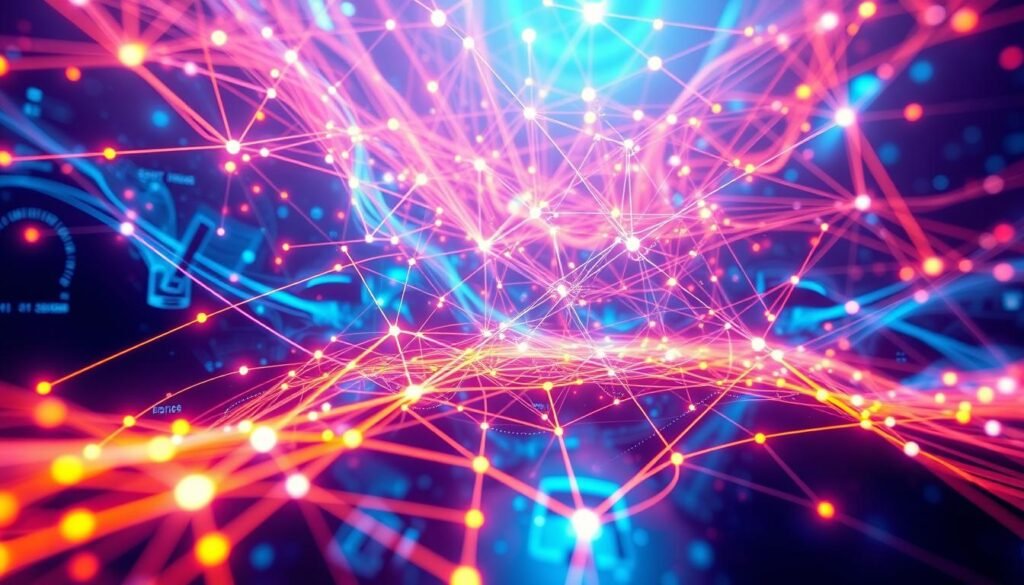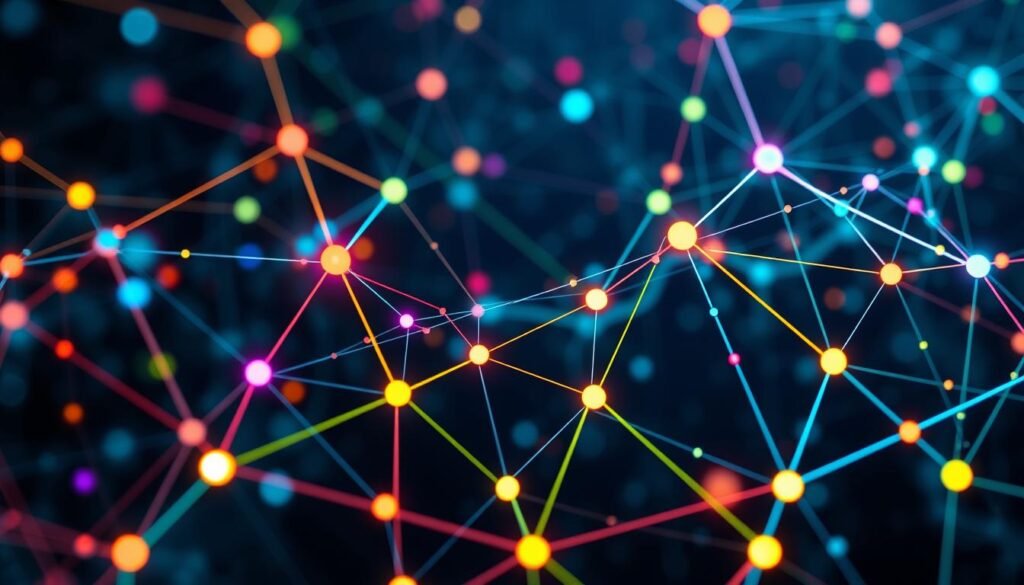In India, 90% of companies are using advanced neural networks to understand complex data. Adaptive recurrent graph networks (ARGN) are at the forefront of this trend. They are a big step forward in machine learning for data that changes over time.
ARGN combines the best of graph models and recurrent architectures. This makes them great for analyzing data that comes in sequences. They are a powerful tool for analyzing and predicting data.

ARGN can change how you analyze data, from predicting traffic to making recommendations. It can spot detailed patterns in data, beating other models. This makes ARGN a top choice for companies wanting to improve their predictions.
Key Takeaways
- Adaptive recurrent graph networks (ARGN) combine graph-based models and recurrent architectures for sequential graph data analysis.
- ARGN can capture fine-grained node-specific spatial and temporal correlations, outperforming state-of-the-art models.
- Adaptive recurrent graph networks have applications in traffic forecasting, recommendation systems, and more.
- ARGN can revolutionize data analysis and prediction tasks in various industries.
- Graph convolutional neural networks, a key component of ARGN, serve as powerful tools for data analysis and modeling.
- ARGN can address challenges in traffic forecasting, such as data sparsity and missing labels.
- Adaptive techniques, like dynamically calculating similarity matrices, can enhance ARGN’s performance.
Understanding Adaptive Recurrent Graph Networks
Exploring graph-based neural networks and recurrent neural networks is key. Adaptive Recurrent Graph Networks (ARGNs) stand out because of their ability to handle complex data over time. They are perfect for tasks like predicting traffic and demand in different areas.
ARGNs’ architecture is built to understand both the spatial and temporal aspects of data. They use graph convolutional layers to spot spatial patterns and recurrent neural network layers for temporal ones.
Core Components of ARGN
ARGNs have three main parts: graph convolutional layers, recurrent neural network layers, and adaptive learning. These work together to help the model learn and predict complex data patterns.
Fundamental Architecture
ARGNs have a layered structure, each layer focused on different data dependencies. This design, combining graph-based and recurrent neural networks, allows for precise predictions.
Key Features and Capabilities
ARGNs excel in tasks like traffic and demand forecasting. They can handle complex data by capturing spatial and temporal dependencies. Their architecture includes graph convolutional and recurrent neural network layers.
Using ARGNs offers several advantages. They improve accuracy and efficiency and can manage complex data. By combining graph-based and recurrent neural networks, ARGNs excel in making precise predictions.
The Evolution of Graph-Based Neural Networks
Exploring graph-based neural networks means looking at their history. It started in 2005, with big steps in graph convolutional networks (GCNs) in 2017. GCNs introduced a new way to work with graph data, leading to more advanced models.
Since then, many Graph Neural Network models have been created. These include GraphSAGE, graph attention networks (GATs), and graph convolutional networks. They’ve shown great results in tasks like text analysis, image recognition, and health data analysis.
There have been many important updates in this field. For example, TransE and TransO models help learn from knowledge graphs. RotatE and QuatE models use new ways to represent data in knowledge graphs.
The rise of graph convolutional networks has been key. GCNs can work with graph data, opening up new areas for research and use. As you delve into Adaptive Recurrent Graph Networks, knowing about the history of graph-based neural networks will help you appreciate ARGNs’ innovation.
How ARGN Transforms Data Analysis
Adaptive Recurrent Graph Networks (ARGN) are changing how we analyze data. They handle complex, dynamic systems well. Adaptive learning algorithms help these networks get better with time.
ARGNs are great at finding patterns in data that changes often. They use sequential graph models to understand data better. This helps in making accurate predictions and informed decisions.
- Real-time traffic analysis: ARGNs can be used to analyze traffic patterns and optimize traffic flow in real-time.
- Financial forecasting: ARGNs can be used to analyze financial data and predict market trends.
- Healthcare analytics: ARGNs can be used to analyze medical data and predict patient outcomes.
ARGNs are making a big impact in data analysis. They use adaptive learning algorithms and sequential graph models to uncover new insights. As you learn more about ARGNs, you’ll see their potential in many fields.
Implementation Strategies for Graph Embeddings
Exploring Adaptive Recurrent Graph Networks means you need to know about graph embeddings. These are low-dimensional vectors that show the structure of graphs. To make good graph embeddings, you can use different methods, like:
- Node embedding methods, which focus on representing individual nodes in a graph
- Subgraph embedding methods, which aim to capture the structural information of subgraphs
- Graph-level embedding methods, which represent the entire graph as a single vector
These methods help create graph embeddings that show the complex relationships in your data. With these embeddings, Adaptive Recurrent Graph Networks can handle graph-structured data better. For example, graph embeddings can help predict node labels, classify graphs, or suggest items in a graph-based system.
When using graph embeddings, it’s key to know their strengths and weaknesses. Some methods work better for certain graphs or tasks, while others need more resources. By understanding the different ways to do graph embeddings, you can choose the best one for your needs.

Mastering graph embeddings lets you fully use Adaptive Recurrent Graph Networks. Whether you’re working with node, subgraph, or graph embeddings, the goal is to pick the right method for your problem. Then, use it well.
Comparing ARGN with Traditional Neural Networks
Traditional Recurrent Neural Networks (RNNs) are good at handling sequential data. But they can struggle with long-term dependencies and graph-structured data. Adaptive Recurrent Graph Networks (ARGNs) offer a better solution.
ARGNs have several benefits over traditional RNNs. They work well with graph-structured data, perfect for social network analysis and traffic forecasting. They also learn long-term dependencies better, leading to improved performance in language modeling and time series prediction.
Advantages over Standard RNNs
- Ability to handle graph-structured data
- Improved performance on tasks that require learning long-term dependencies
- Flexibility and adaptability in various applications
ARGNs are a big step up from traditional RNNs, especially for tasks involving graph data and long-term dependencies. They use the strengths of recurrent neural networks to deliver more accurate and reliable results. This makes them a valuable asset in many fields.
Optimizing Your ARGN Model
To get the most out of your Adaptive Recurrent Graph Networks (ARGN) model, optimizing its performance is key. Adaptive learning algorithms are crucial in this process. They help your model learn faster and perform better. Fine-tuning your model makes it better at complex data analysis tasks.
Optimizing your ARGN model involves several strategies. These include hyperparameter tuning, regularization, and preventing overfitting. You can also use adaptive learning algorithms to tailor your model for specific data types or use cases. Techniques like early stopping, dropout, and batch normalization can help prevent overfitting and improve generalization.
Moreover, you can apply optimization techniques like genetic algorithms to your model’s architecture and features. This helps find the optimal combination of hyperparameters and architecture for your problem. By doing this, you can greatly enhance your ARGN model’s performance and generalization, leading to top results in various fields.

Some notable optimization techniques involve combining adaptive learning algorithms with other models, like convolutional neural networks and recurrent neural networks. These methods have shown high accuracy in tasks like image classification and natural language processing.
Real-World Applications in Indian Industries
Adaptive Recurrent Graph Networks have many uses in Indian industries. They help improve various sectors. For example, in finance, they change how we assess risks, detect fraud, and predict markets.
In healthcare, they help with better patient care. They make diagnoses more accurate and create personalized treatment plans. For instance, medical imaging analysis uses these networks to spot patterns and anomalies in images. They also help analyze electronic health records for better treatment plans.
Financial Sector Implementation
The financial sector benefits a lot from graph convolutional networks. They help analyze transactional data to find fraud patterns. This reduces financial losses. They also predict stock market trends, helping investors make better choices.
Healthcare Analytics
In healthcare, these networks analyze medical data to understand patient outcomes. They can spot high-risk patients and offer personalized care to improve their health.
Smart City Infrastructure
Graph convolutional networks also help in smart city development. They improve traffic management systems and energy management systems. By analyzing real-time data, they help cities manage resources better and reduce waste.
Some key uses of graph convolutional networks in Indian industries include:
- Predicting stock market trends
- Identifying potential fraud patterns in transactional data
- Analyzing medical data to provide insights into patient outcomes
- Developing smart city infrastructure, including traffic management systems and energy management systems
These examples show how graph convolutional networks are making a difference in Indian industries. As the technology grows, we’ll see even more innovative uses in the future.
Conclusion: Embracing the Future with ARGN
As we finish our exploration of adaptive recurrent graph networks (ARGNs), it’s clear they have a big role to play. They can change how we look at and understand complex data. This is true for things like transportation, social networks, and even watching the environment.
Research in this area is always moving forward. This means we’ll soon have even better tools to find important insights and make smart choices. By using ARGNs, you’ll be ready to handle the complex data of the future. This is true whether you work in finance, healthcare, or smart cities.
To keep up with this exciting field, you need to keep learning and growing. Look into the newest discoveries, work with experts, and think about how you can use ARGNs in your work. This way, you’ll open up new chances for creativity and use these models to their fullest in your field.
Remember, we all have a part in shaping the future. By using adaptive recurrent graph networks, you’ll be helping to solve big problems and move your field forward.
FAQ
What are Adaptive Recurrent Graph Networks (ARGNs)?
Adaptive Recurrent Graph Networks (ARGNs) are a new machine learning technology. They are a big step forward in analyzing complex data. This data changes over time, making ARGNs great for many tasks.
How do ARGNs differ from traditional neural network models?
ARGNs have a unique structure that lets them handle complex data over time. They are better than standard RNNs at finding patterns in data. This makes them more useful for some tasks.
What are the key features and capabilities of ARGNs?
ARGNs can adapt to changing data and find patterns in real-time. They are good at working with sequential data. This helps uncover insights that were hard to find before.
How do ARGNs leverage graph embeddings?
Graph embeddings are key for ARGNs. They help understand the complex relationships in data. ARGNs use different methods to create these embeddings, making data analysis more efficient.
What are the real-world applications of ARGNs in Indian industries?
ARGNs are changing many industries in India. They help in finance for risk assessment and fraud detection. In healthcare, they improve diagnostics and treatment plans. They also help in smart cities by optimizing traffic and energy use.
What skills and knowledge are needed to work with ARGNs?
Working with ARGNs requires knowledge of machine learning and graph theory. You also need to understand adaptive learning and graph embeddings. This knowledge is essential for using ARGNs effectively.
Also Read
E learning website project with source Code using HTML CSS and JavaScript 2024-25
Explainable ai xai geeksforgeeks in python
Best truck game html css javascript 2024 25
